An Analysis of Power and Hierarchy in Australian Healthcare Systems
VerifiedAdded on 2021/06/17
|13
|3603
|80
Essay
AI Summary
This essay provides a comprehensive analysis of health sociology in Australia, focusing on the intricate interplay of power and hierarchy within the healthcare system. It delves into the sociological concepts and theories such as functionalism, feminism, and Marxism to elucidate the structures and dynamics that shape healthcare practices. The essay explores how power is manifested through professional roles, gender disparities, and the historical evolution of medical dominance, particularly examining the influence of Foucaultian theory. It investigates the impact of these power dynamics on healthcare professionals, patients, and the overall quality of care. Furthermore, the essay examines the intersection of social class and gender inequalities within the Australian healthcare system, highlighting the implications of these factors on the distribution of resources and the experiences of both healthcare providers and recipients. By critically analyzing the historical context and contemporary issues, the essay offers valuable insights into the complexities of the Australian healthcare system and its sociological dimensions.
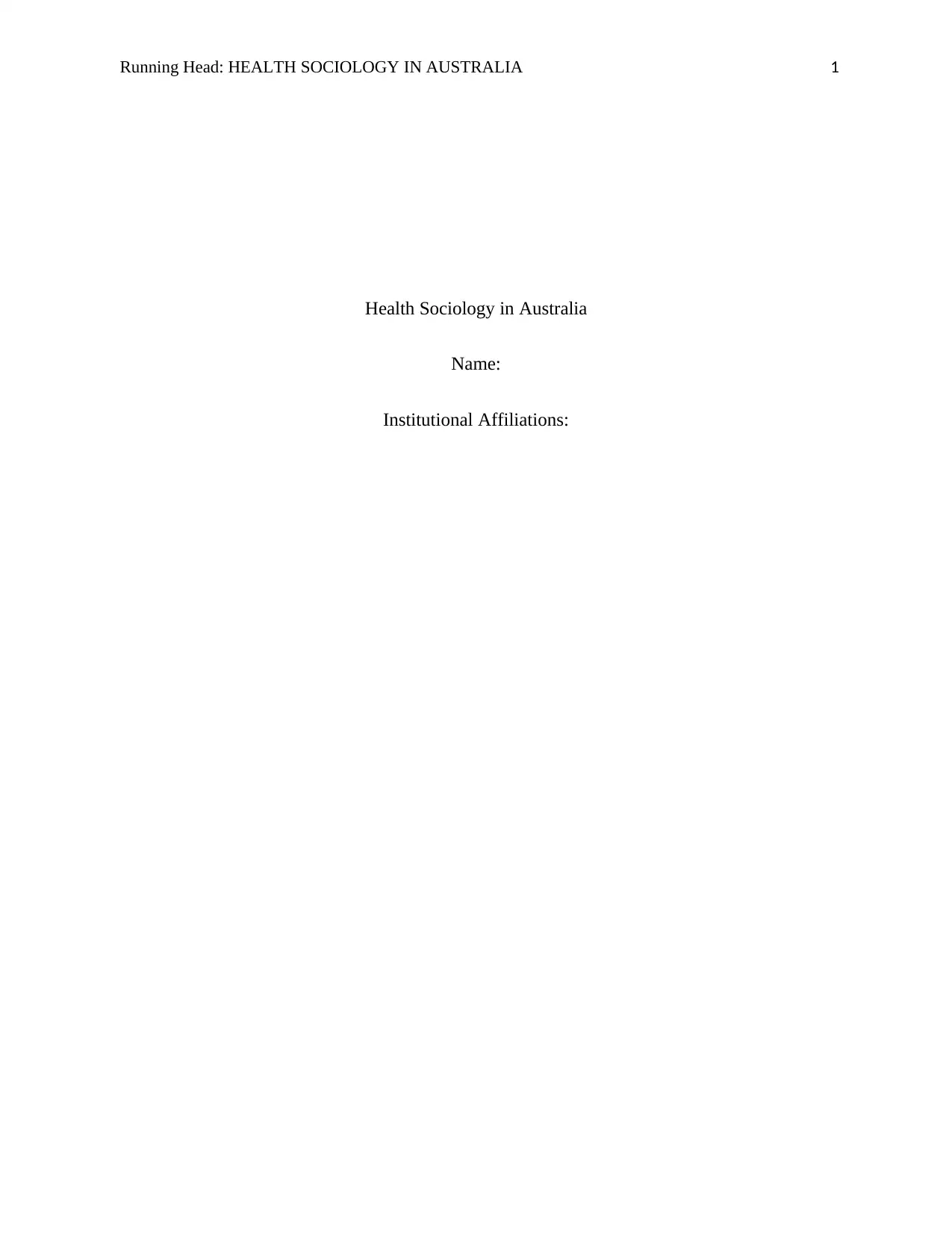
Running Head: HEALTH SOCIOLOGY IN AUSTRALIA 1
Health Sociology in Australia
Name:
Institutional Affiliations:
Health Sociology in Australia
Name:
Institutional Affiliations:
Paraphrase This Document
Need a fresh take? Get an instant paraphrase of this document with our AI Paraphraser
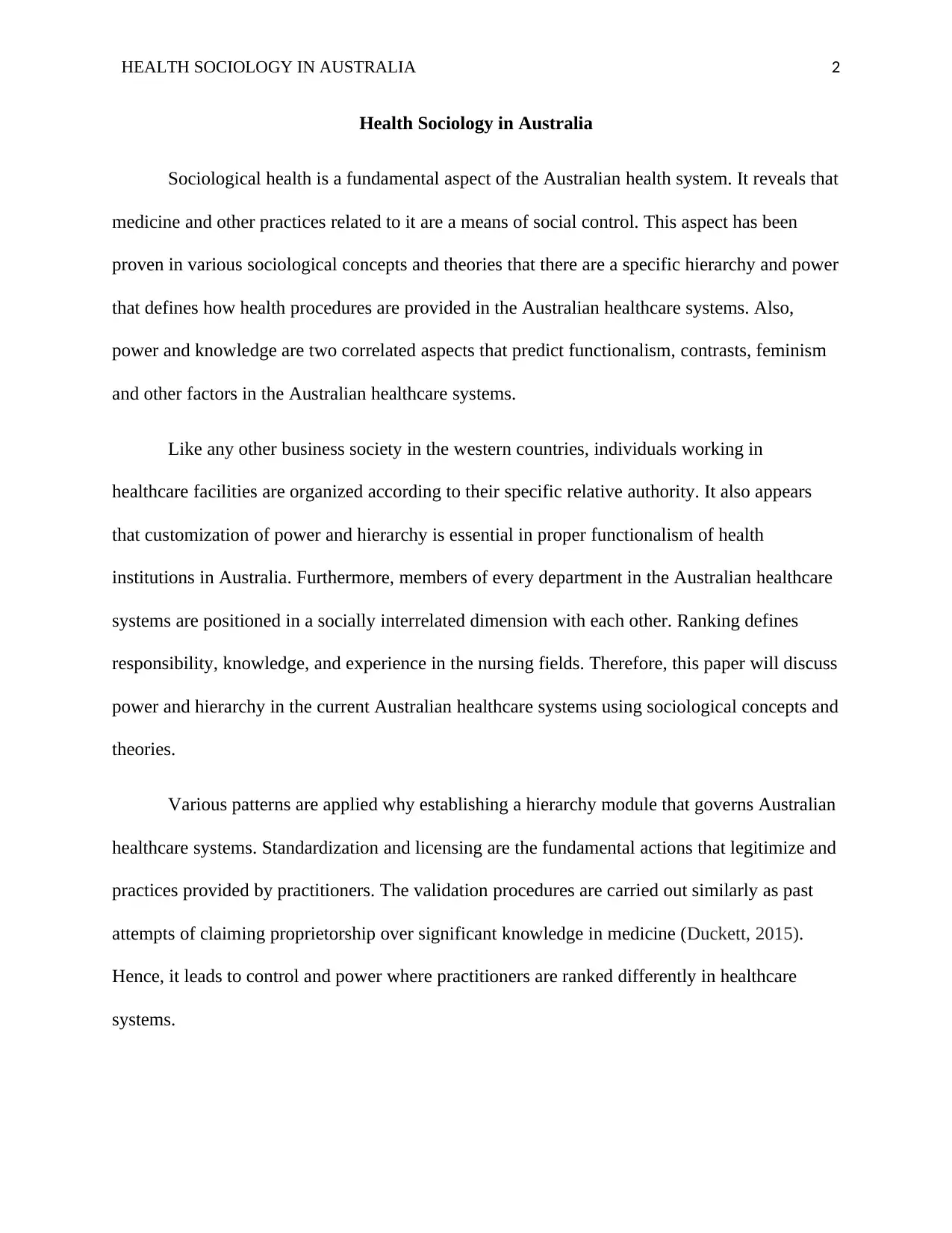
HEALTH SOCIOLOGY IN AUSTRALIA 2
Health Sociology in Australia
Sociological health is a fundamental aspect of the Australian health system. It reveals that
medicine and other practices related to it are a means of social control. This aspect has been
proven in various sociological concepts and theories that there are a specific hierarchy and power
that defines how health procedures are provided in the Australian healthcare systems. Also,
power and knowledge are two correlated aspects that predict functionalism, contrasts, feminism
and other factors in the Australian healthcare systems.
Like any other business society in the western countries, individuals working in
healthcare facilities are organized according to their specific relative authority. It also appears
that customization of power and hierarchy is essential in proper functionalism of health
institutions in Australia. Furthermore, members of every department in the Australian healthcare
systems are positioned in a socially interrelated dimension with each other. Ranking defines
responsibility, knowledge, and experience in the nursing fields. Therefore, this paper will discuss
power and hierarchy in the current Australian healthcare systems using sociological concepts and
theories.
Various patterns are applied why establishing a hierarchy module that governs Australian
healthcare systems. Standardization and licensing are the fundamental actions that legitimize and
practices provided by practitioners. The validation procedures are carried out similarly as past
attempts of claiming proprietorship over significant knowledge in medicine (Duckett, 2015).
Hence, it leads to control and power where practitioners are ranked differently in healthcare
systems.
Health Sociology in Australia
Sociological health is a fundamental aspect of the Australian health system. It reveals that
medicine and other practices related to it are a means of social control. This aspect has been
proven in various sociological concepts and theories that there are a specific hierarchy and power
that defines how health procedures are provided in the Australian healthcare systems. Also,
power and knowledge are two correlated aspects that predict functionalism, contrasts, feminism
and other factors in the Australian healthcare systems.
Like any other business society in the western countries, individuals working in
healthcare facilities are organized according to their specific relative authority. It also appears
that customization of power and hierarchy is essential in proper functionalism of health
institutions in Australia. Furthermore, members of every department in the Australian healthcare
systems are positioned in a socially interrelated dimension with each other. Ranking defines
responsibility, knowledge, and experience in the nursing fields. Therefore, this paper will discuss
power and hierarchy in the current Australian healthcare systems using sociological concepts and
theories.
Various patterns are applied why establishing a hierarchy module that governs Australian
healthcare systems. Standardization and licensing are the fundamental actions that legitimize and
practices provided by practitioners. The validation procedures are carried out similarly as past
attempts of claiming proprietorship over significant knowledge in medicine (Duckett, 2015).
Hence, it leads to control and power where practitioners are ranked differently in healthcare
systems.
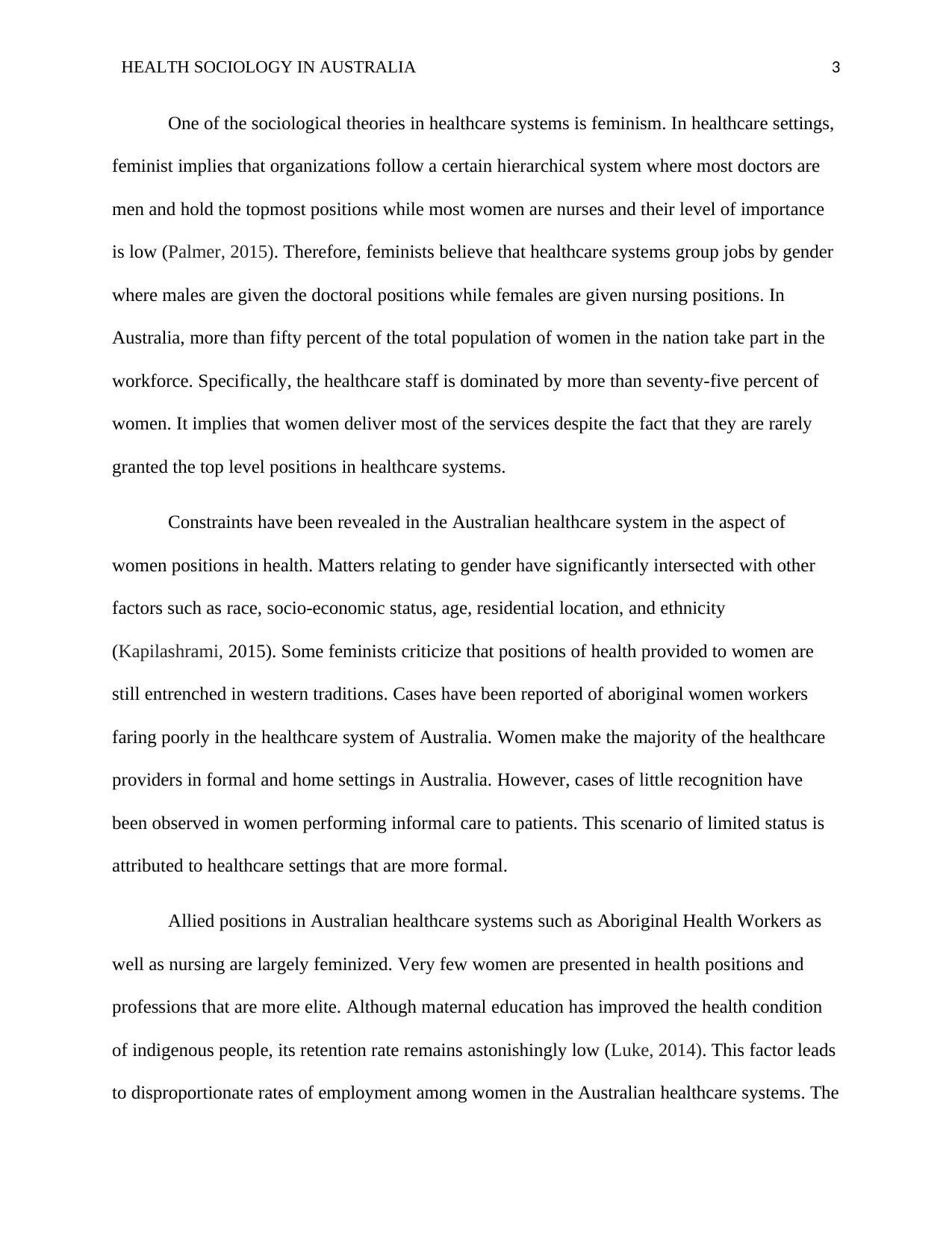
HEALTH SOCIOLOGY IN AUSTRALIA 3
One of the sociological theories in healthcare systems is feminism. In healthcare settings,
feminist implies that organizations follow a certain hierarchical system where most doctors are
men and hold the topmost positions while most women are nurses and their level of importance
is low (Palmer, 2015). Therefore, feminists believe that healthcare systems group jobs by gender
where males are given the doctoral positions while females are given nursing positions. In
Australia, more than fifty percent of the total population of women in the nation take part in the
workforce. Specifically, the healthcare staff is dominated by more than seventy-five percent of
women. It implies that women deliver most of the services despite the fact that they are rarely
granted the top level positions in healthcare systems.
Constraints have been revealed in the Australian healthcare system in the aspect of
women positions in health. Matters relating to gender have significantly intersected with other
factors such as race, socio-economic status, age, residential location, and ethnicity
(Kapilashrami, 2015). Some feminists criticize that positions of health provided to women are
still entrenched in western traditions. Cases have been reported of aboriginal women workers
faring poorly in the healthcare system of Australia. Women make the majority of the healthcare
providers in formal and home settings in Australia. However, cases of little recognition have
been observed in women performing informal care to patients. This scenario of limited status is
attributed to healthcare settings that are more formal.
Allied positions in Australian healthcare systems such as Aboriginal Health Workers as
well as nursing are largely feminized. Very few women are presented in health positions and
professions that are more elite. Although maternal education has improved the health condition
of indigenous people, its retention rate remains astonishingly low (Luke, 2014). This factor leads
to disproportionate rates of employment among women in the Australian healthcare systems. The
One of the sociological theories in healthcare systems is feminism. In healthcare settings,
feminist implies that organizations follow a certain hierarchical system where most doctors are
men and hold the topmost positions while most women are nurses and their level of importance
is low (Palmer, 2015). Therefore, feminists believe that healthcare systems group jobs by gender
where males are given the doctoral positions while females are given nursing positions. In
Australia, more than fifty percent of the total population of women in the nation take part in the
workforce. Specifically, the healthcare staff is dominated by more than seventy-five percent of
women. It implies that women deliver most of the services despite the fact that they are rarely
granted the top level positions in healthcare systems.
Constraints have been revealed in the Australian healthcare system in the aspect of
women positions in health. Matters relating to gender have significantly intersected with other
factors such as race, socio-economic status, age, residential location, and ethnicity
(Kapilashrami, 2015). Some feminists criticize that positions of health provided to women are
still entrenched in western traditions. Cases have been reported of aboriginal women workers
faring poorly in the healthcare system of Australia. Women make the majority of the healthcare
providers in formal and home settings in Australia. However, cases of little recognition have
been observed in women performing informal care to patients. This scenario of limited status is
attributed to healthcare settings that are more formal.
Allied positions in Australian healthcare systems such as Aboriginal Health Workers as
well as nursing are largely feminized. Very few women are presented in health positions and
professions that are more elite. Although maternal education has improved the health condition
of indigenous people, its retention rate remains astonishingly low (Luke, 2014). This factor leads
to disproportionate rates of employment among women in the Australian healthcare systems. The
⊘ This is a preview!⊘
Do you want full access?
Subscribe today to unlock all pages.

Trusted by 1+ million students worldwide
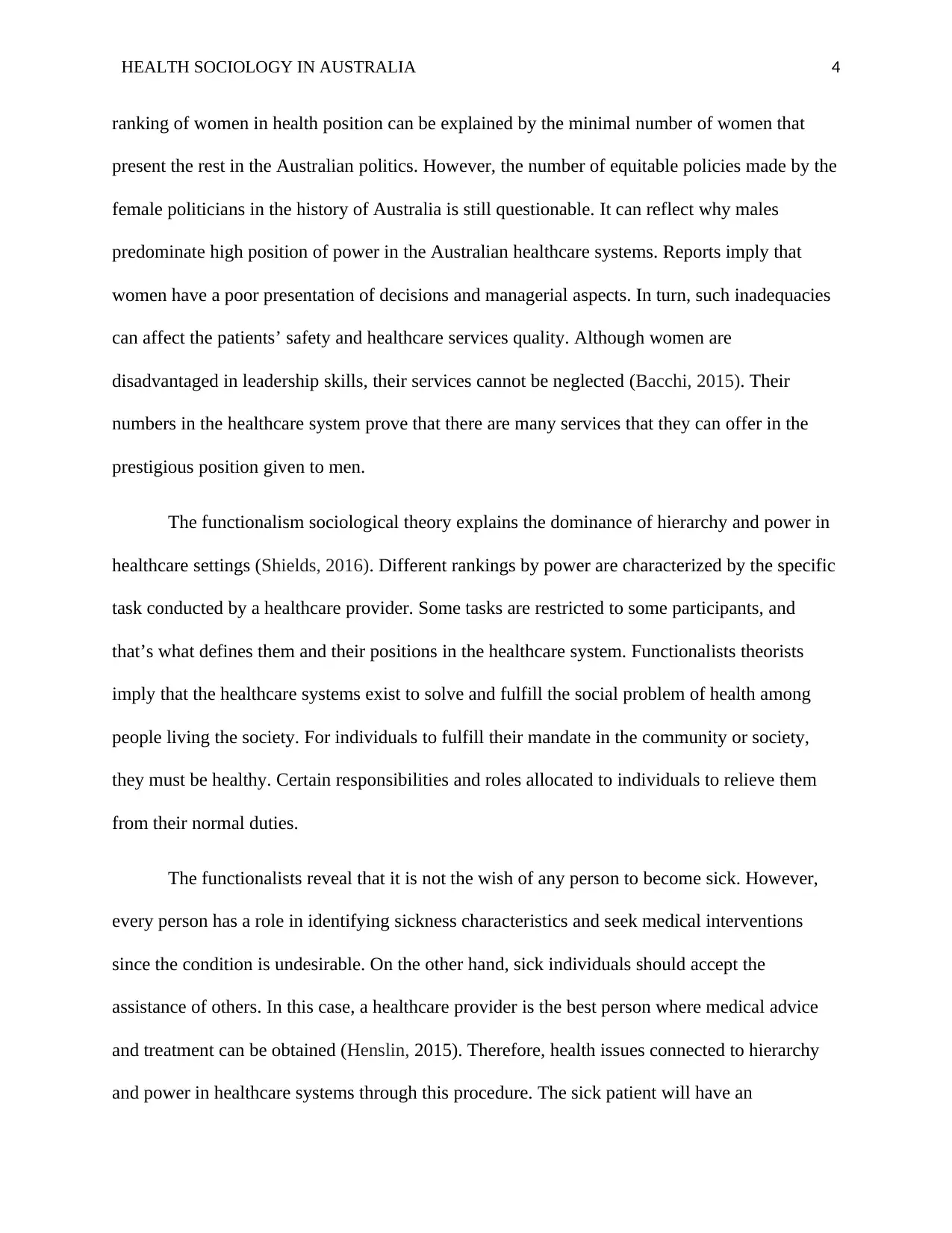
HEALTH SOCIOLOGY IN AUSTRALIA 4
ranking of women in health position can be explained by the minimal number of women that
present the rest in the Australian politics. However, the number of equitable policies made by the
female politicians in the history of Australia is still questionable. It can reflect why males
predominate high position of power in the Australian healthcare systems. Reports imply that
women have a poor presentation of decisions and managerial aspects. In turn, such inadequacies
can affect the patients’ safety and healthcare services quality. Although women are
disadvantaged in leadership skills, their services cannot be neglected (Bacchi, 2015). Their
numbers in the healthcare system prove that there are many services that they can offer in the
prestigious position given to men.
The functionalism sociological theory explains the dominance of hierarchy and power in
healthcare settings (Shields, 2016). Different rankings by power are characterized by the specific
task conducted by a healthcare provider. Some tasks are restricted to some participants, and
that’s what defines them and their positions in the healthcare system. Functionalists theorists
imply that the healthcare systems exist to solve and fulfill the social problem of health among
people living the society. For individuals to fulfill their mandate in the community or society,
they must be healthy. Certain responsibilities and roles allocated to individuals to relieve them
from their normal duties.
The functionalists reveal that it is not the wish of any person to become sick. However,
every person has a role in identifying sickness characteristics and seek medical interventions
since the condition is undesirable. On the other hand, sick individuals should accept the
assistance of others. In this case, a healthcare provider is the best person where medical advice
and treatment can be obtained (Henslin, 2015). Therefore, health issues connected to hierarchy
and power in healthcare systems through this procedure. The sick patient will have an
ranking of women in health position can be explained by the minimal number of women that
present the rest in the Australian politics. However, the number of equitable policies made by the
female politicians in the history of Australia is still questionable. It can reflect why males
predominate high position of power in the Australian healthcare systems. Reports imply that
women have a poor presentation of decisions and managerial aspects. In turn, such inadequacies
can affect the patients’ safety and healthcare services quality. Although women are
disadvantaged in leadership skills, their services cannot be neglected (Bacchi, 2015). Their
numbers in the healthcare system prove that there are many services that they can offer in the
prestigious position given to men.
The functionalism sociological theory explains the dominance of hierarchy and power in
healthcare settings (Shields, 2016). Different rankings by power are characterized by the specific
task conducted by a healthcare provider. Some tasks are restricted to some participants, and
that’s what defines them and their positions in the healthcare system. Functionalists theorists
imply that the healthcare systems exist to solve and fulfill the social problem of health among
people living the society. For individuals to fulfill their mandate in the community or society,
they must be healthy. Certain responsibilities and roles allocated to individuals to relieve them
from their normal duties.
The functionalists reveal that it is not the wish of any person to become sick. However,
every person has a role in identifying sickness characteristics and seek medical interventions
since the condition is undesirable. On the other hand, sick individuals should accept the
assistance of others. In this case, a healthcare provider is the best person where medical advice
and treatment can be obtained (Henslin, 2015). Therefore, health issues connected to hierarchy
and power in healthcare systems through this procedure. The sick patient will have an
Paraphrase This Document
Need a fresh take? Get an instant paraphrase of this document with our AI Paraphraser
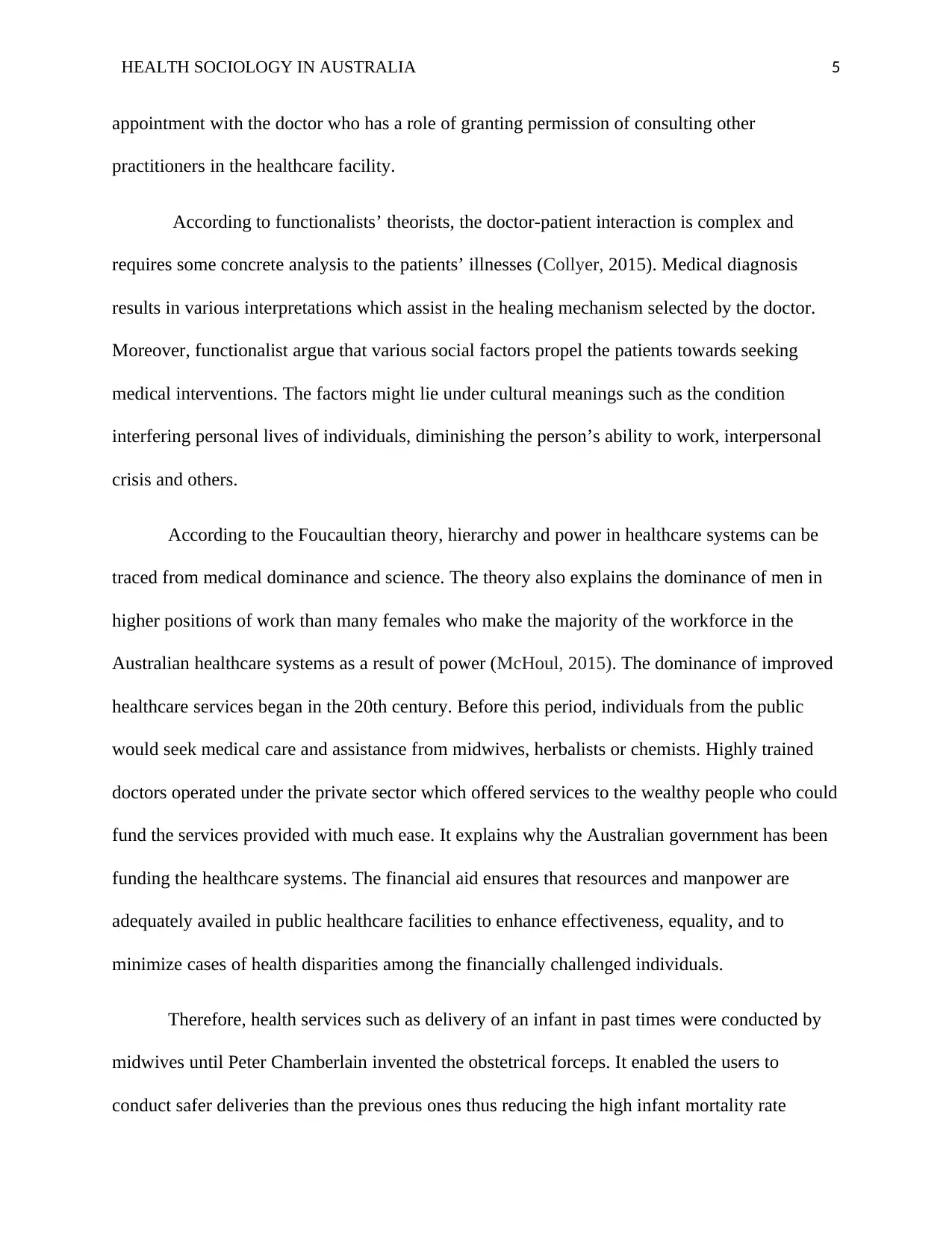
HEALTH SOCIOLOGY IN AUSTRALIA 5
appointment with the doctor who has a role of granting permission of consulting other
practitioners in the healthcare facility.
According to functionalists’ theorists, the doctor-patient interaction is complex and
requires some concrete analysis to the patients’ illnesses (Collyer, 2015). Medical diagnosis
results in various interpretations which assist in the healing mechanism selected by the doctor.
Moreover, functionalist argue that various social factors propel the patients towards seeking
medical interventions. The factors might lie under cultural meanings such as the condition
interfering personal lives of individuals, diminishing the person’s ability to work, interpersonal
crisis and others.
According to the Foucaultian theory, hierarchy and power in healthcare systems can be
traced from medical dominance and science. The theory also explains the dominance of men in
higher positions of work than many females who make the majority of the workforce in the
Australian healthcare systems as a result of power (McHoul, 2015). The dominance of improved
healthcare services began in the 20th century. Before this period, individuals from the public
would seek medical care and assistance from midwives, herbalists or chemists. Highly trained
doctors operated under the private sector which offered services to the wealthy people who could
fund the services provided with much ease. It explains why the Australian government has been
funding the healthcare systems. The financial aid ensures that resources and manpower are
adequately availed in public healthcare facilities to enhance effectiveness, equality, and to
minimize cases of health disparities among the financially challenged individuals.
Therefore, health services such as delivery of an infant in past times were conducted by
midwives until Peter Chamberlain invented the obstetrical forceps. It enabled the users to
conduct safer deliveries than the previous ones thus reducing the high infant mortality rate
appointment with the doctor who has a role of granting permission of consulting other
practitioners in the healthcare facility.
According to functionalists’ theorists, the doctor-patient interaction is complex and
requires some concrete analysis to the patients’ illnesses (Collyer, 2015). Medical diagnosis
results in various interpretations which assist in the healing mechanism selected by the doctor.
Moreover, functionalist argue that various social factors propel the patients towards seeking
medical interventions. The factors might lie under cultural meanings such as the condition
interfering personal lives of individuals, diminishing the person’s ability to work, interpersonal
crisis and others.
According to the Foucaultian theory, hierarchy and power in healthcare systems can be
traced from medical dominance and science. The theory also explains the dominance of men in
higher positions of work than many females who make the majority of the workforce in the
Australian healthcare systems as a result of power (McHoul, 2015). The dominance of improved
healthcare services began in the 20th century. Before this period, individuals from the public
would seek medical care and assistance from midwives, herbalists or chemists. Highly trained
doctors operated under the private sector which offered services to the wealthy people who could
fund the services provided with much ease. It explains why the Australian government has been
funding the healthcare systems. The financial aid ensures that resources and manpower are
adequately availed in public healthcare facilities to enhance effectiveness, equality, and to
minimize cases of health disparities among the financially challenged individuals.
Therefore, health services such as delivery of an infant in past times were conducted by
midwives until Peter Chamberlain invented the obstetrical forceps. It enabled the users to
conduct safer deliveries than the previous ones thus reducing the high infant mortality rate
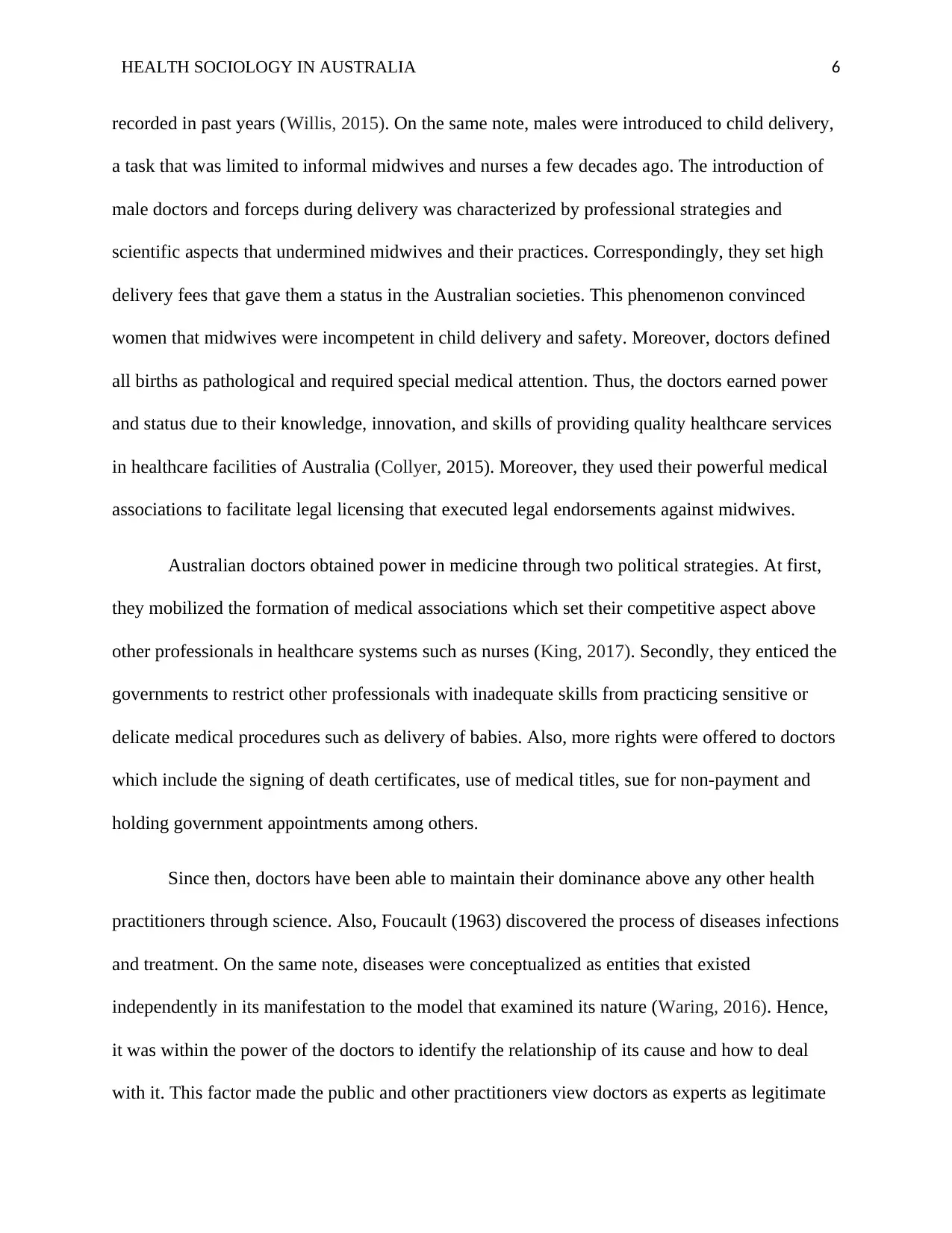
HEALTH SOCIOLOGY IN AUSTRALIA 6
recorded in past years (Willis, 2015). On the same note, males were introduced to child delivery,
a task that was limited to informal midwives and nurses a few decades ago. The introduction of
male doctors and forceps during delivery was characterized by professional strategies and
scientific aspects that undermined midwives and their practices. Correspondingly, they set high
delivery fees that gave them a status in the Australian societies. This phenomenon convinced
women that midwives were incompetent in child delivery and safety. Moreover, doctors defined
all births as pathological and required special medical attention. Thus, the doctors earned power
and status due to their knowledge, innovation, and skills of providing quality healthcare services
in healthcare facilities of Australia (Collyer, 2015). Moreover, they used their powerful medical
associations to facilitate legal licensing that executed legal endorsements against midwives.
Australian doctors obtained power in medicine through two political strategies. At first,
they mobilized the formation of medical associations which set their competitive aspect above
other professionals in healthcare systems such as nurses (King, 2017). Secondly, they enticed the
governments to restrict other professionals with inadequate skills from practicing sensitive or
delicate medical procedures such as delivery of babies. Also, more rights were offered to doctors
which include the signing of death certificates, use of medical titles, sue for non-payment and
holding government appointments among others.
Since then, doctors have been able to maintain their dominance above any other health
practitioners through science. Also, Foucault (1963) discovered the process of diseases infections
and treatment. On the same note, diseases were conceptualized as entities that existed
independently in its manifestation to the model that examined its nature (Waring, 2016). Hence,
it was within the power of the doctors to identify the relationship of its cause and how to deal
with it. This factor made the public and other practitioners view doctors as experts as legitimate
recorded in past years (Willis, 2015). On the same note, males were introduced to child delivery,
a task that was limited to informal midwives and nurses a few decades ago. The introduction of
male doctors and forceps during delivery was characterized by professional strategies and
scientific aspects that undermined midwives and their practices. Correspondingly, they set high
delivery fees that gave them a status in the Australian societies. This phenomenon convinced
women that midwives were incompetent in child delivery and safety. Moreover, doctors defined
all births as pathological and required special medical attention. Thus, the doctors earned power
and status due to their knowledge, innovation, and skills of providing quality healthcare services
in healthcare facilities of Australia (Collyer, 2015). Moreover, they used their powerful medical
associations to facilitate legal licensing that executed legal endorsements against midwives.
Australian doctors obtained power in medicine through two political strategies. At first,
they mobilized the formation of medical associations which set their competitive aspect above
other professionals in healthcare systems such as nurses (King, 2017). Secondly, they enticed the
governments to restrict other professionals with inadequate skills from practicing sensitive or
delicate medical procedures such as delivery of babies. Also, more rights were offered to doctors
which include the signing of death certificates, use of medical titles, sue for non-payment and
holding government appointments among others.
Since then, doctors have been able to maintain their dominance above any other health
practitioners through science. Also, Foucault (1963) discovered the process of diseases infections
and treatment. On the same note, diseases were conceptualized as entities that existed
independently in its manifestation to the model that examined its nature (Waring, 2016). Hence,
it was within the power of the doctors to identify the relationship of its cause and how to deal
with it. This factor made the public and other practitioners view doctors as experts as legitimate
⊘ This is a preview!⊘
Do you want full access?
Subscribe today to unlock all pages.

Trusted by 1+ million students worldwide
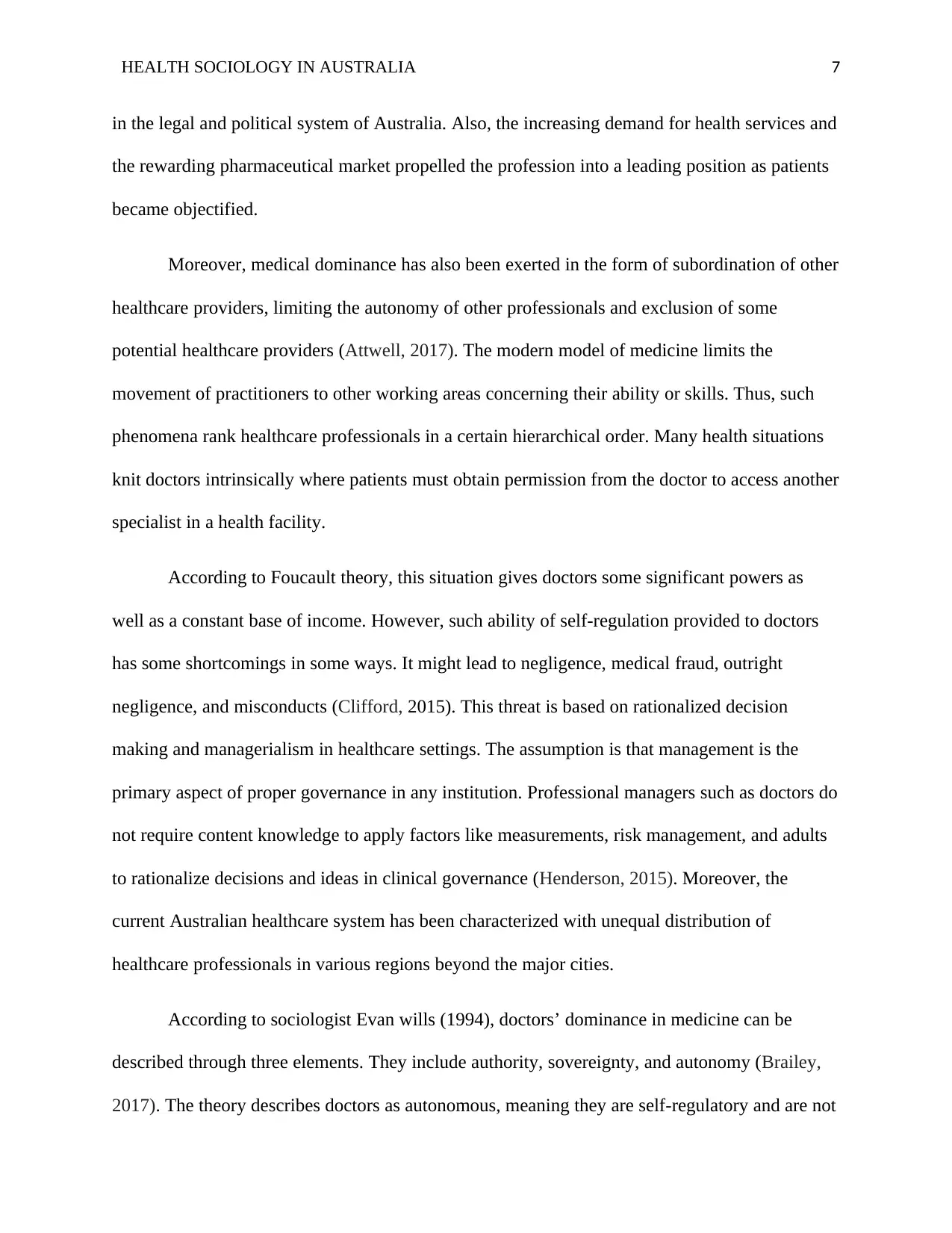
HEALTH SOCIOLOGY IN AUSTRALIA 7
in the legal and political system of Australia. Also, the increasing demand for health services and
the rewarding pharmaceutical market propelled the profession into a leading position as patients
became objectified.
Moreover, medical dominance has also been exerted in the form of subordination of other
healthcare providers, limiting the autonomy of other professionals and exclusion of some
potential healthcare providers (Attwell, 2017). The modern model of medicine limits the
movement of practitioners to other working areas concerning their ability or skills. Thus, such
phenomena rank healthcare professionals in a certain hierarchical order. Many health situations
knit doctors intrinsically where patients must obtain permission from the doctor to access another
specialist in a health facility.
According to Foucault theory, this situation gives doctors some significant powers as
well as a constant base of income. However, such ability of self-regulation provided to doctors
has some shortcomings in some ways. It might lead to negligence, medical fraud, outright
negligence, and misconducts (Clifford, 2015). This threat is based on rationalized decision
making and managerialism in healthcare settings. The assumption is that management is the
primary aspect of proper governance in any institution. Professional managers such as doctors do
not require content knowledge to apply factors like measurements, risk management, and adults
to rationalize decisions and ideas in clinical governance (Henderson, 2015). Moreover, the
current Australian healthcare system has been characterized with unequal distribution of
healthcare professionals in various regions beyond the major cities.
According to sociologist Evan wills (1994), doctors’ dominance in medicine can be
described through three elements. They include authority, sovereignty, and autonomy (Brailey,
2017). The theory describes doctors as autonomous, meaning they are self-regulatory and are not
in the legal and political system of Australia. Also, the increasing demand for health services and
the rewarding pharmaceutical market propelled the profession into a leading position as patients
became objectified.
Moreover, medical dominance has also been exerted in the form of subordination of other
healthcare providers, limiting the autonomy of other professionals and exclusion of some
potential healthcare providers (Attwell, 2017). The modern model of medicine limits the
movement of practitioners to other working areas concerning their ability or skills. Thus, such
phenomena rank healthcare professionals in a certain hierarchical order. Many health situations
knit doctors intrinsically where patients must obtain permission from the doctor to access another
specialist in a health facility.
According to Foucault theory, this situation gives doctors some significant powers as
well as a constant base of income. However, such ability of self-regulation provided to doctors
has some shortcomings in some ways. It might lead to negligence, medical fraud, outright
negligence, and misconducts (Clifford, 2015). This threat is based on rationalized decision
making and managerialism in healthcare settings. The assumption is that management is the
primary aspect of proper governance in any institution. Professional managers such as doctors do
not require content knowledge to apply factors like measurements, risk management, and adults
to rationalize decisions and ideas in clinical governance (Henderson, 2015). Moreover, the
current Australian healthcare system has been characterized with unequal distribution of
healthcare professionals in various regions beyond the major cities.
According to sociologist Evan wills (1994), doctors’ dominance in medicine can be
described through three elements. They include authority, sovereignty, and autonomy (Brailey,
2017). The theory describes doctors as autonomous, meaning they are self-regulatory and are not
Paraphrase This Document
Need a fresh take? Get an instant paraphrase of this document with our AI Paraphraser
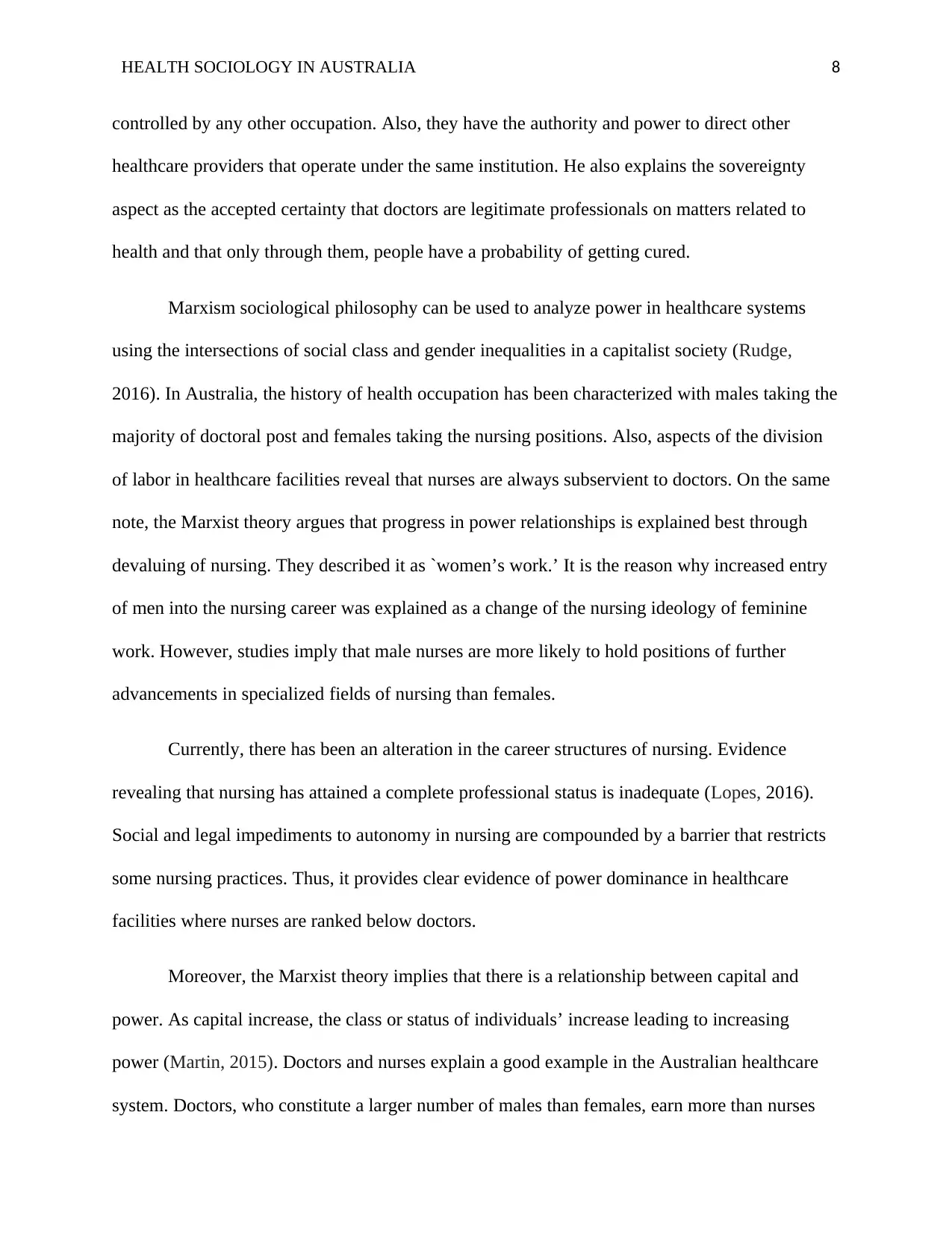
HEALTH SOCIOLOGY IN AUSTRALIA 8
controlled by any other occupation. Also, they have the authority and power to direct other
healthcare providers that operate under the same institution. He also explains the sovereignty
aspect as the accepted certainty that doctors are legitimate professionals on matters related to
health and that only through them, people have a probability of getting cured.
Marxism sociological philosophy can be used to analyze power in healthcare systems
using the intersections of social class and gender inequalities in a capitalist society (Rudge,
2016). In Australia, the history of health occupation has been characterized with males taking the
majority of doctoral post and females taking the nursing positions. Also, aspects of the division
of labor in healthcare facilities reveal that nurses are always subservient to doctors. On the same
note, the Marxist theory argues that progress in power relationships is explained best through
devaluing of nursing. They described it as `women’s work.’ It is the reason why increased entry
of men into the nursing career was explained as a change of the nursing ideology of feminine
work. However, studies imply that male nurses are more likely to hold positions of further
advancements in specialized fields of nursing than females.
Currently, there has been an alteration in the career structures of nursing. Evidence
revealing that nursing has attained a complete professional status is inadequate (Lopes, 2016).
Social and legal impediments to autonomy in nursing are compounded by a barrier that restricts
some nursing practices. Thus, it provides clear evidence of power dominance in healthcare
facilities where nurses are ranked below doctors.
Moreover, the Marxist theory implies that there is a relationship between capital and
power. As capital increase, the class or status of individuals’ increase leading to increasing
power (Martin, 2015). Doctors and nurses explain a good example in the Australian healthcare
system. Doctors, who constitute a larger number of males than females, earn more than nurses
controlled by any other occupation. Also, they have the authority and power to direct other
healthcare providers that operate under the same institution. He also explains the sovereignty
aspect as the accepted certainty that doctors are legitimate professionals on matters related to
health and that only through them, people have a probability of getting cured.
Marxism sociological philosophy can be used to analyze power in healthcare systems
using the intersections of social class and gender inequalities in a capitalist society (Rudge,
2016). In Australia, the history of health occupation has been characterized with males taking the
majority of doctoral post and females taking the nursing positions. Also, aspects of the division
of labor in healthcare facilities reveal that nurses are always subservient to doctors. On the same
note, the Marxist theory argues that progress in power relationships is explained best through
devaluing of nursing. They described it as `women’s work.’ It is the reason why increased entry
of men into the nursing career was explained as a change of the nursing ideology of feminine
work. However, studies imply that male nurses are more likely to hold positions of further
advancements in specialized fields of nursing than females.
Currently, there has been an alteration in the career structures of nursing. Evidence
revealing that nursing has attained a complete professional status is inadequate (Lopes, 2016).
Social and legal impediments to autonomy in nursing are compounded by a barrier that restricts
some nursing practices. Thus, it provides clear evidence of power dominance in healthcare
facilities where nurses are ranked below doctors.
Moreover, the Marxist theory implies that there is a relationship between capital and
power. As capital increase, the class or status of individuals’ increase leading to increasing
power (Martin, 2015). Doctors and nurses explain a good example in the Australian healthcare
system. Doctors, who constitute a larger number of males than females, earn more than nurses
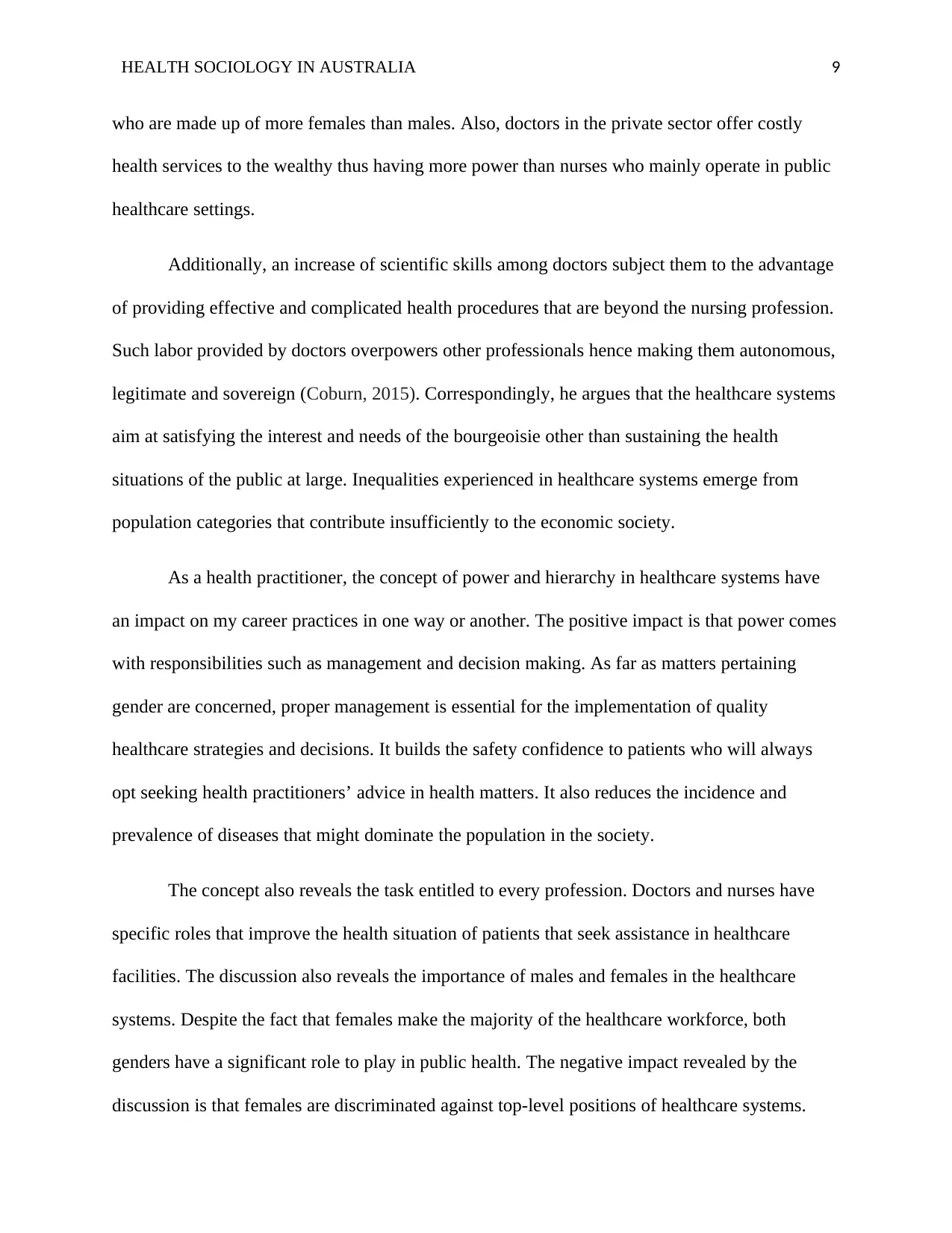
HEALTH SOCIOLOGY IN AUSTRALIA 9
who are made up of more females than males. Also, doctors in the private sector offer costly
health services to the wealthy thus having more power than nurses who mainly operate in public
healthcare settings.
Additionally, an increase of scientific skills among doctors subject them to the advantage
of providing effective and complicated health procedures that are beyond the nursing profession.
Such labor provided by doctors overpowers other professionals hence making them autonomous,
legitimate and sovereign (Coburn, 2015). Correspondingly, he argues that the healthcare systems
aim at satisfying the interest and needs of the bourgeoisie other than sustaining the health
situations of the public at large. Inequalities experienced in healthcare systems emerge from
population categories that contribute insufficiently to the economic society.
As a health practitioner, the concept of power and hierarchy in healthcare systems have
an impact on my career practices in one way or another. The positive impact is that power comes
with responsibilities such as management and decision making. As far as matters pertaining
gender are concerned, proper management is essential for the implementation of quality
healthcare strategies and decisions. It builds the safety confidence to patients who will always
opt seeking health practitioners’ advice in health matters. It also reduces the incidence and
prevalence of diseases that might dominate the population in the society.
The concept also reveals the task entitled to every profession. Doctors and nurses have
specific roles that improve the health situation of patients that seek assistance in healthcare
facilities. The discussion also reveals the importance of males and females in the healthcare
systems. Despite the fact that females make the majority of the healthcare workforce, both
genders have a significant role to play in public health. The negative impact revealed by the
discussion is that females are discriminated against top-level positions of healthcare systems.
who are made up of more females than males. Also, doctors in the private sector offer costly
health services to the wealthy thus having more power than nurses who mainly operate in public
healthcare settings.
Additionally, an increase of scientific skills among doctors subject them to the advantage
of providing effective and complicated health procedures that are beyond the nursing profession.
Such labor provided by doctors overpowers other professionals hence making them autonomous,
legitimate and sovereign (Coburn, 2015). Correspondingly, he argues that the healthcare systems
aim at satisfying the interest and needs of the bourgeoisie other than sustaining the health
situations of the public at large. Inequalities experienced in healthcare systems emerge from
population categories that contribute insufficiently to the economic society.
As a health practitioner, the concept of power and hierarchy in healthcare systems have
an impact on my career practices in one way or another. The positive impact is that power comes
with responsibilities such as management and decision making. As far as matters pertaining
gender are concerned, proper management is essential for the implementation of quality
healthcare strategies and decisions. It builds the safety confidence to patients who will always
opt seeking health practitioners’ advice in health matters. It also reduces the incidence and
prevalence of diseases that might dominate the population in the society.
The concept also reveals the task entitled to every profession. Doctors and nurses have
specific roles that improve the health situation of patients that seek assistance in healthcare
facilities. The discussion also reveals the importance of males and females in the healthcare
systems. Despite the fact that females make the majority of the healthcare workforce, both
genders have a significant role to play in public health. The negative impact revealed by the
discussion is that females are discriminated against top-level positions of healthcare systems.
⊘ This is a preview!⊘
Do you want full access?
Subscribe today to unlock all pages.

Trusted by 1+ million students worldwide
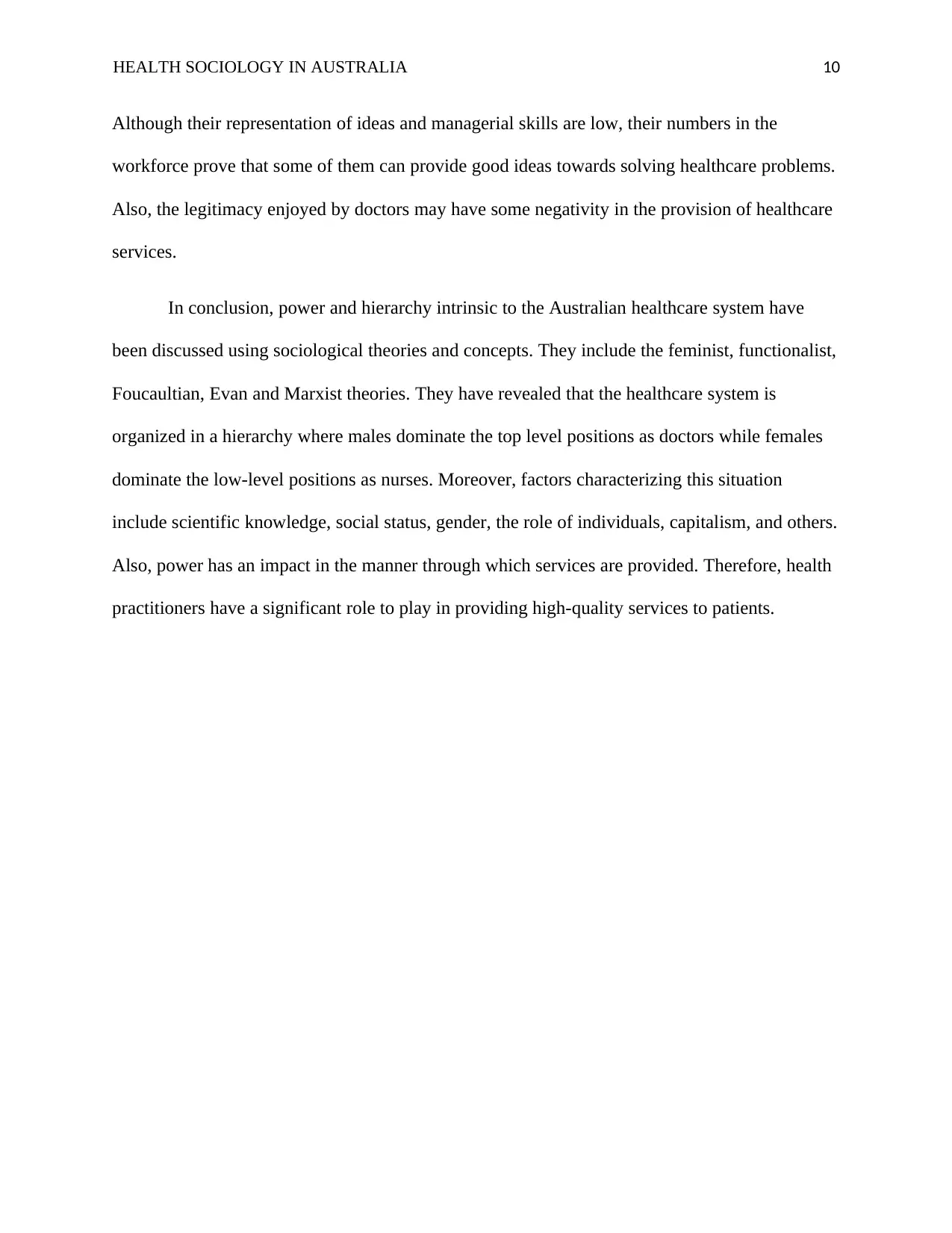
HEALTH SOCIOLOGY IN AUSTRALIA 10
Although their representation of ideas and managerial skills are low, their numbers in the
workforce prove that some of them can provide good ideas towards solving healthcare problems.
Also, the legitimacy enjoyed by doctors may have some negativity in the provision of healthcare
services.
In conclusion, power and hierarchy intrinsic to the Australian healthcare system have
been discussed using sociological theories and concepts. They include the feminist, functionalist,
Foucaultian, Evan and Marxist theories. They have revealed that the healthcare system is
organized in a hierarchy where males dominate the top level positions as doctors while females
dominate the low-level positions as nurses. Moreover, factors characterizing this situation
include scientific knowledge, social status, gender, the role of individuals, capitalism, and others.
Also, power has an impact in the manner through which services are provided. Therefore, health
practitioners have a significant role to play in providing high-quality services to patients.
Although their representation of ideas and managerial skills are low, their numbers in the
workforce prove that some of them can provide good ideas towards solving healthcare problems.
Also, the legitimacy enjoyed by doctors may have some negativity in the provision of healthcare
services.
In conclusion, power and hierarchy intrinsic to the Australian healthcare system have
been discussed using sociological theories and concepts. They include the feminist, functionalist,
Foucaultian, Evan and Marxist theories. They have revealed that the healthcare system is
organized in a hierarchy where males dominate the top level positions as doctors while females
dominate the low-level positions as nurses. Moreover, factors characterizing this situation
include scientific knowledge, social status, gender, the role of individuals, capitalism, and others.
Also, power has an impact in the manner through which services are provided. Therefore, health
practitioners have a significant role to play in providing high-quality services to patients.
Paraphrase This Document
Need a fresh take? Get an instant paraphrase of this document with our AI Paraphraser
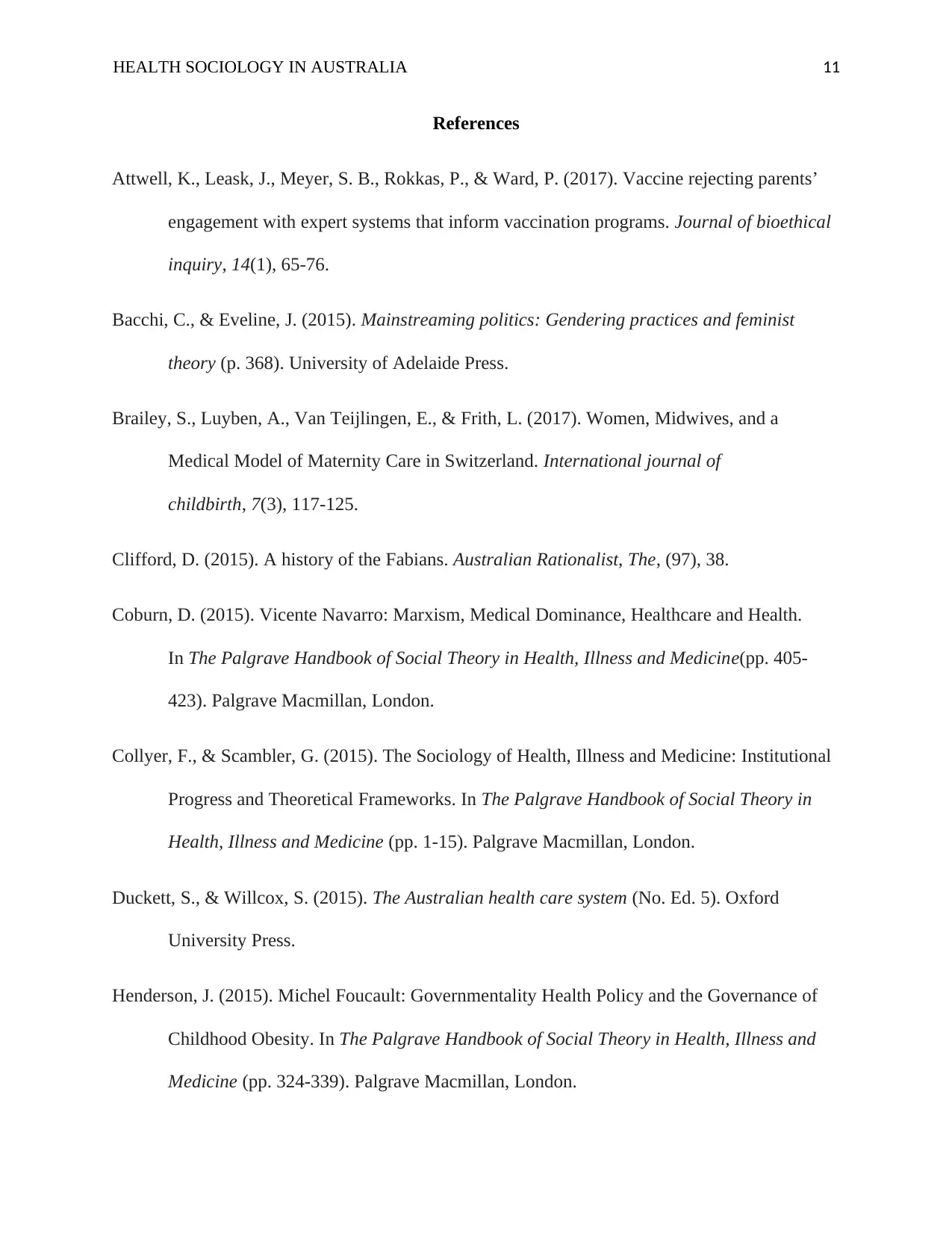
HEALTH SOCIOLOGY IN AUSTRALIA 11
References
Attwell, K., Leask, J., Meyer, S. B., Rokkas, P., & Ward, P. (2017). Vaccine rejecting parents’
engagement with expert systems that inform vaccination programs. Journal of bioethical
inquiry, 14(1), 65-76.
Bacchi, C., & Eveline, J. (2015). Mainstreaming politics: Gendering practices and feminist
theory (p. 368). University of Adelaide Press.
Brailey, S., Luyben, A., Van Teijlingen, E., & Frith, L. (2017). Women, Midwives, and a
Medical Model of Maternity Care in Switzerland. International journal of
childbirth, 7(3), 117-125.
Clifford, D. (2015). A history of the Fabians. Australian Rationalist, The, (97), 38.
Coburn, D. (2015). Vicente Navarro: Marxism, Medical Dominance, Healthcare and Health.
In The Palgrave Handbook of Social Theory in Health, Illness and Medicine(pp. 405-
423). Palgrave Macmillan, London.
Collyer, F., & Scambler, G. (2015). The Sociology of Health, Illness and Medicine: Institutional
Progress and Theoretical Frameworks. In The Palgrave Handbook of Social Theory in
Health, Illness and Medicine (pp. 1-15). Palgrave Macmillan, London.
Duckett, S., & Willcox, S. (2015). The Australian health care system (No. Ed. 5). Oxford
University Press.
Henderson, J. (2015). Michel Foucault: Governmentality Health Policy and the Governance of
Childhood Obesity. In The Palgrave Handbook of Social Theory in Health, Illness and
Medicine (pp. 324-339). Palgrave Macmillan, London.
References
Attwell, K., Leask, J., Meyer, S. B., Rokkas, P., & Ward, P. (2017). Vaccine rejecting parents’
engagement with expert systems that inform vaccination programs. Journal of bioethical
inquiry, 14(1), 65-76.
Bacchi, C., & Eveline, J. (2015). Mainstreaming politics: Gendering practices and feminist
theory (p. 368). University of Adelaide Press.
Brailey, S., Luyben, A., Van Teijlingen, E., & Frith, L. (2017). Women, Midwives, and a
Medical Model of Maternity Care in Switzerland. International journal of
childbirth, 7(3), 117-125.
Clifford, D. (2015). A history of the Fabians. Australian Rationalist, The, (97), 38.
Coburn, D. (2015). Vicente Navarro: Marxism, Medical Dominance, Healthcare and Health.
In The Palgrave Handbook of Social Theory in Health, Illness and Medicine(pp. 405-
423). Palgrave Macmillan, London.
Collyer, F., & Scambler, G. (2015). The Sociology of Health, Illness and Medicine: Institutional
Progress and Theoretical Frameworks. In The Palgrave Handbook of Social Theory in
Health, Illness and Medicine (pp. 1-15). Palgrave Macmillan, London.
Duckett, S., & Willcox, S. (2015). The Australian health care system (No. Ed. 5). Oxford
University Press.
Henderson, J. (2015). Michel Foucault: Governmentality Health Policy and the Governance of
Childhood Obesity. In The Palgrave Handbook of Social Theory in Health, Illness and
Medicine (pp. 324-339). Palgrave Macmillan, London.
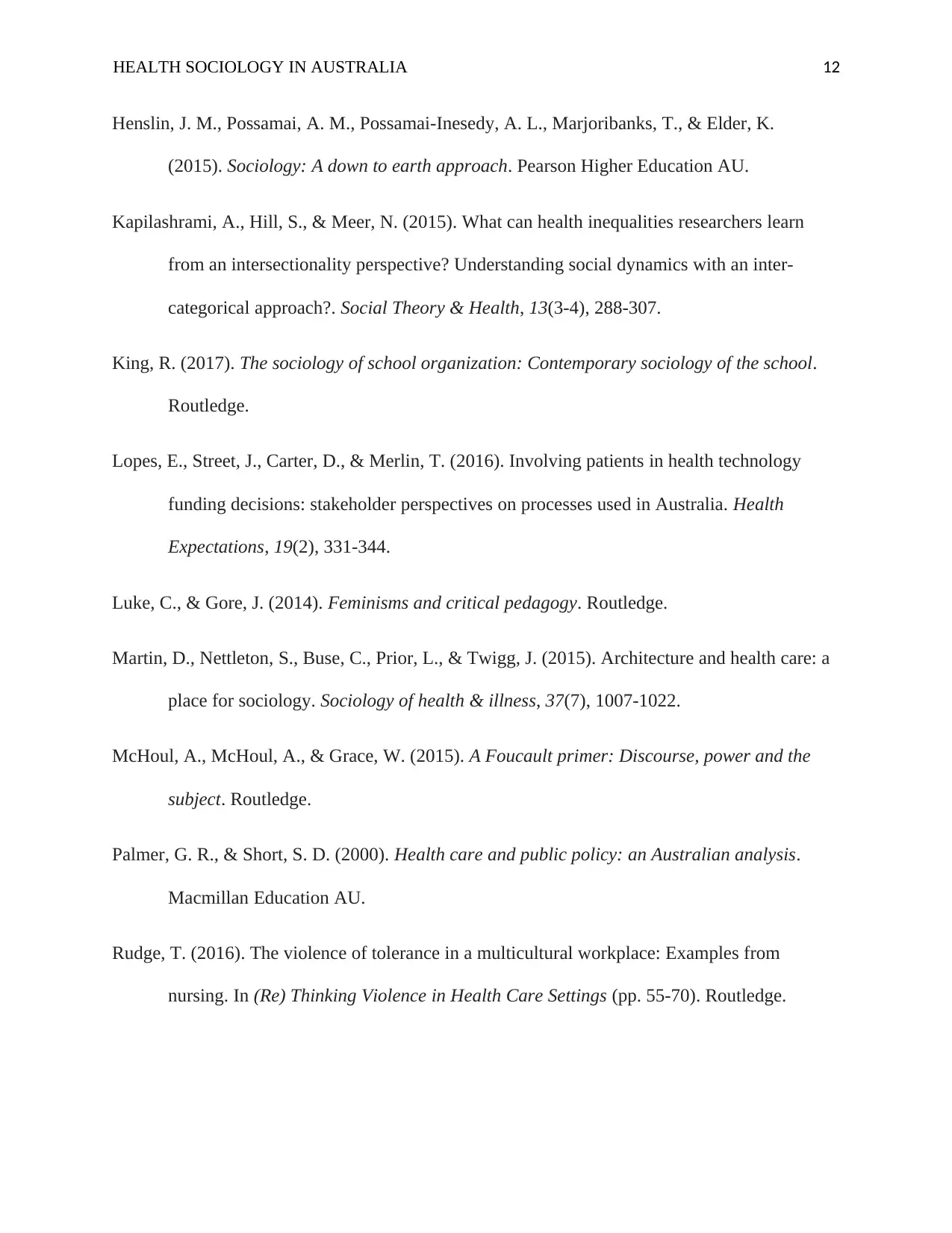
HEALTH SOCIOLOGY IN AUSTRALIA 12
Henslin, J. M., Possamai, A. M., Possamai-Inesedy, A. L., Marjoribanks, T., & Elder, K.
(2015). Sociology: A down to earth approach. Pearson Higher Education AU.
Kapilashrami, A., Hill, S., & Meer, N. (2015). What can health inequalities researchers learn
from an intersectionality perspective? Understanding social dynamics with an inter-
categorical approach?. Social Theory & Health, 13(3-4), 288-307.
King, R. (2017). The sociology of school organization: Contemporary sociology of the school.
Routledge.
Lopes, E., Street, J., Carter, D., & Merlin, T. (2016). Involving patients in health technology
funding decisions: stakeholder perspectives on processes used in Australia. Health
Expectations, 19(2), 331-344.
Luke, C., & Gore, J. (2014). Feminisms and critical pedagogy. Routledge.
Martin, D., Nettleton, S., Buse, C., Prior, L., & Twigg, J. (2015). Architecture and health care: a
place for sociology. Sociology of health & illness, 37(7), 1007-1022.
McHoul, A., McHoul, A., & Grace, W. (2015). A Foucault primer: Discourse, power and the
subject. Routledge.
Palmer, G. R., & Short, S. D. (2000). Health care and public policy: an Australian analysis.
Macmillan Education AU.
Rudge, T. (2016). The violence of tolerance in a multicultural workplace: Examples from
nursing. In (Re) Thinking Violence in Health Care Settings (pp. 55-70). Routledge.
Henslin, J. M., Possamai, A. M., Possamai-Inesedy, A. L., Marjoribanks, T., & Elder, K.
(2015). Sociology: A down to earth approach. Pearson Higher Education AU.
Kapilashrami, A., Hill, S., & Meer, N. (2015). What can health inequalities researchers learn
from an intersectionality perspective? Understanding social dynamics with an inter-
categorical approach?. Social Theory & Health, 13(3-4), 288-307.
King, R. (2017). The sociology of school organization: Contemporary sociology of the school.
Routledge.
Lopes, E., Street, J., Carter, D., & Merlin, T. (2016). Involving patients in health technology
funding decisions: stakeholder perspectives on processes used in Australia. Health
Expectations, 19(2), 331-344.
Luke, C., & Gore, J. (2014). Feminisms and critical pedagogy. Routledge.
Martin, D., Nettleton, S., Buse, C., Prior, L., & Twigg, J. (2015). Architecture and health care: a
place for sociology. Sociology of health & illness, 37(7), 1007-1022.
McHoul, A., McHoul, A., & Grace, W. (2015). A Foucault primer: Discourse, power and the
subject. Routledge.
Palmer, G. R., & Short, S. D. (2000). Health care and public policy: an Australian analysis.
Macmillan Education AU.
Rudge, T. (2016). The violence of tolerance in a multicultural workplace: Examples from
nursing. In (Re) Thinking Violence in Health Care Settings (pp. 55-70). Routledge.
⊘ This is a preview!⊘
Do you want full access?
Subscribe today to unlock all pages.

Trusted by 1+ million students worldwide
1 out of 13
Related Documents
Your All-in-One AI-Powered Toolkit for Academic Success.
+13062052269
info@desklib.com
Available 24*7 on WhatsApp / Email
![[object Object]](/_next/static/media/star-bottom.7253800d.svg)
Unlock your academic potential
Copyright © 2020–2025 A2Z Services. All Rights Reserved. Developed and managed by ZUCOL.



